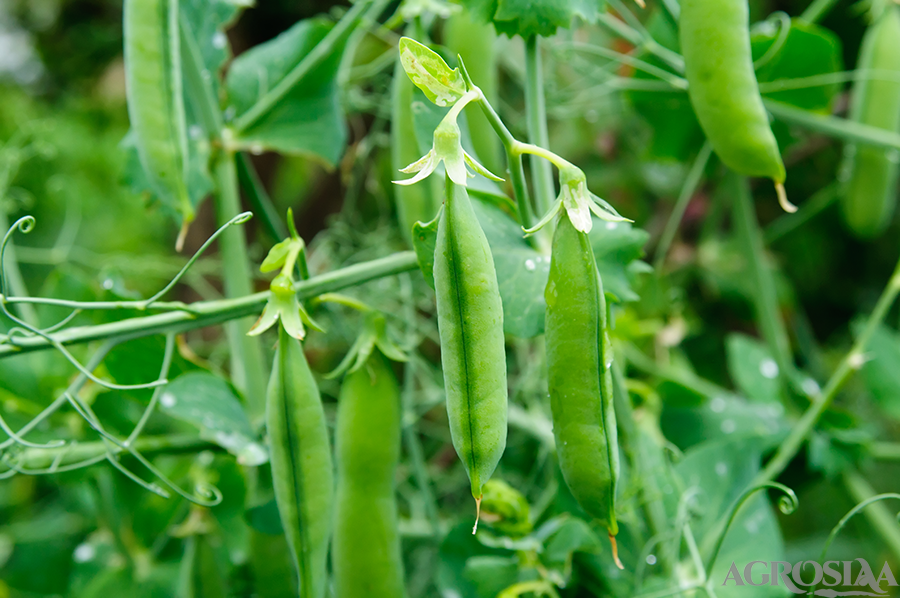Watana / Matar
Leguminoceae
Pisum sativum
Bonneville, Early Badger, English wonder, Wai Early, Wai Late, Khaperkheda, Selection 82, Selection 83, Arkel-1, Harbhajan, Jawahar Matar-1, Pant Uphar
It is cultivated mostly in Rabi season. Now it is cultivated in kharif season also.
Cold climate is favourable for the pea crop. Optimum temperature range 12.5 0 c to 18.5 0 c is good for growth. It can tolerate cold , susceptible to frost and dew at flowering.
medium to heavy, well drained soil is required for this crop.
One ploughing followed by 2-3 harrowing sufficient to prepare seed bed.
a) seeds are soaked in water for 24 hrs. to ensure good germiantion and treated with hirum @ 3 gm /kg of seed or Captan 2.5 g/kg seed or Bavistin 2 g/kg seed or Thirum 2 g + Bavistin 1 g/kg seed are recommended for controlling seed borne fungal diseases.
b) Seed treatement with Rhizobium culture @ 250 g/10 kg of the seed.
Drilling by using two bowl seed drill or dibbling (two seeds/hill) at 30 cm apart. It is also sown behind the plough by dropping it in the plough furrow.
1) In rabi season proper time for sowing is done in 15 th October to 15 th November and in kharif in the month of 15 th June to 15 th July.
Distance between two rows is 30 cm and distance between two plant is 15 cm.It was observed that 30 cm spacing increased the yield by 18.5 % compared to 45 cm spacing.
For dibbling method- 30-40 kg/ha
For drilling 70-80 kg/ha
a) Thinning is done 20 days after sowing.
b) Weeding and hoeing – two to three weedings are necessary staking or support is necessary to avoid the lodging for this purpose stakes are fixed near the stem and pea branches are tied to the stakes.
FYM or Compost @ 10-12 tones/ha . Recommended dose of N:P:K is 15:60:60 kg /ha is to be applied at the time of sowing and 10 kg ‘N’ 30 days after sowing.
Total water requirement of the crop is 30 ha.cm. The sowing is doenafter presoakingirrigation. The other irrigations are scheduled at an interval of 12-15 days. Under limited water supply two irrigations are applied at 45 and 75 days after sowing that results in 40 % yield increase. If only one irrigation is to be applied it should be scheduled at 45 days.
Two to three weedings are necessary for this crop.
Powdery Mildew – Spraying of sulphur 25 gmor Dinocap 10 ml in 10m lit water. Wilt disease – before sowing treated the seed with 5 gm Tricoderma/ Captan or Carbendizum 3 to 4 g/kg of seed. At the time of sowing mix 5-6 kg Tricoderma posder with compost mixed with soil.
Aphid and Jassids
1) spraying of Methyl Dematon 10 ml or Emadachlorprid 4 ml in 10 lit of water. Pod borer- spraying of Endosulphan 20 ml or Deltramethrin 5 ml or HANPV 10 ml in 10 lit.of water or spray 4% Nimboli Arc.
For vegetable purpose hand picking about three to four are required.
For the grain purpose plant is harvested when pods and plants dried.
They are either picked or harvested with the help of sickle and threshed with the sticks after full drying.
Irrigated crop 15-20 Qtls/ha. While yield from rainfed one is 6-8 Qtls. /ha.
Green pods for vegetable purpose 40-60 qtls/ha.
Average yield of dry grains 1.5 to 2 tons /ha.
Stored dried seed in storage bins,, gunny bags, polythene bags.
important vegetable crop, dry seed for vegetable
1) Very popular crop throughout the world.
2) It provides variety of vegetable dishes and threfore it is liked every where.
3) Seed contain 19.7 % protein and vitamins like A,B and C. At some places, it is also used as the fodder crop. It helps in improving soil fertility.
grading and cleaning package in 30 kg bags.
Madhya Pradesh, Uttar Pradesh, Bihar, Punjab, Maharashtra
Madhya Pradesh, Uttar Pradesh, Bihar, Punjab, Maharashtra










